Analysis of Hawthorne Effect, Human Relations Theory for Company X
VerifiedAdded on 2022/12/03
|6
|1176
|333
Homework Assignment
AI Summary
This assignment analyzes the Hawthorne Effect and Human Relations Theory in the context of Company X. The analysis begins by defining Theory X and its negative implications, as observed in the company's management practices, where favoritism and lack of recognition prevail, contrasting with the company's mission and values. The assignment then explores how to apply Theory Y to create a positive work environment, recommending changes to reward systems and decision-making processes to boost employee morale and motivation. The contradictions between Company X's mission and its treatment of employees are highlighted, emphasizing the need for management to prioritize employee welfare to improve productivity and align with the Human Relations Theory. Finally, the assignment suggests methods for measuring employee efficiency in programming and emphasizes the importance of encouraging and motivating employees, and promoting based on achievements to foster a more effective and engaged workforce.
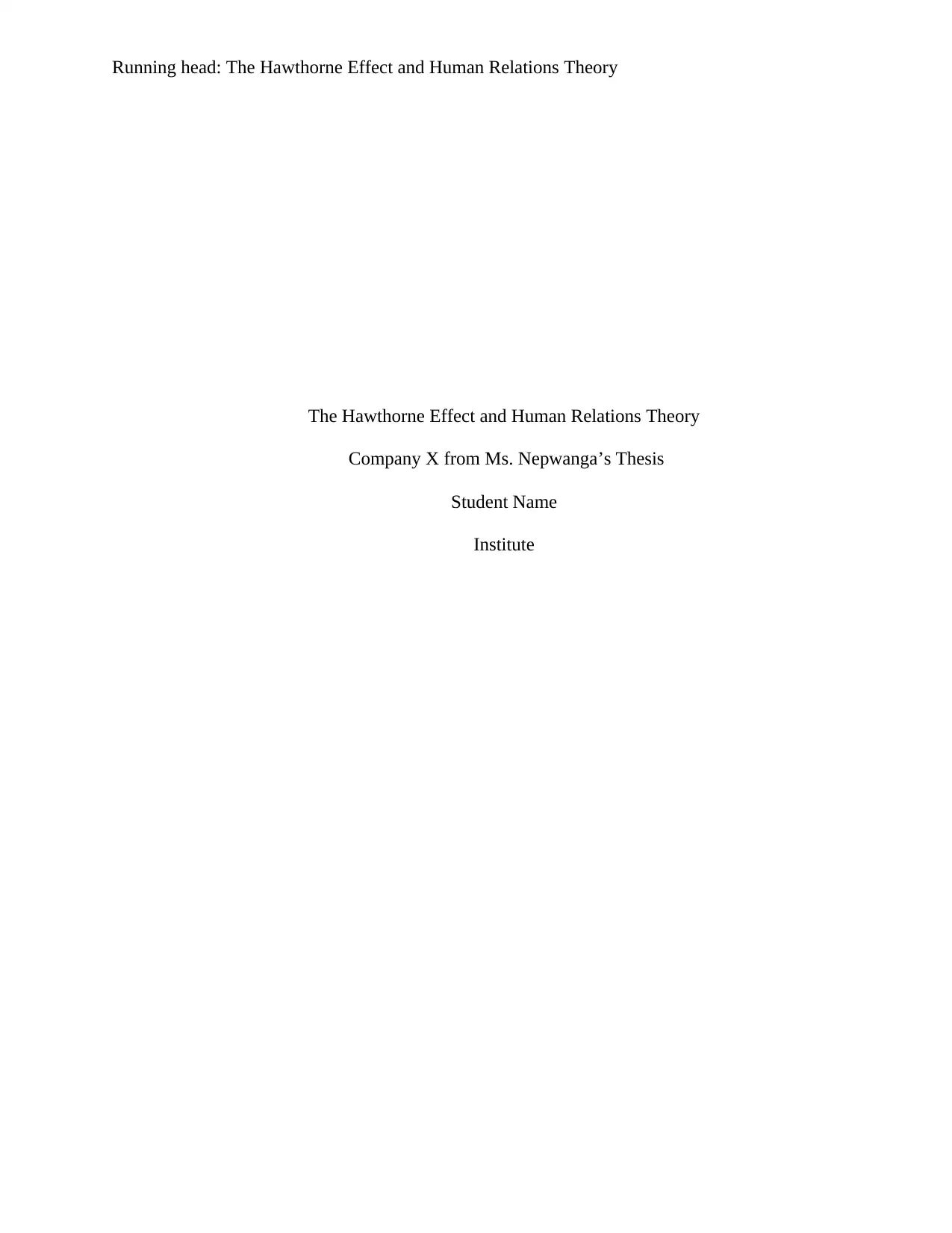
Running head: The Hawthorne Effect and Human Relations Theory
The Hawthorne Effect and Human Relations Theory
Company X from Ms. Nepwanga’s Thesis
Student Name
Institute
The Hawthorne Effect and Human Relations Theory
Company X from Ms. Nepwanga’s Thesis
Student Name
Institute
Paraphrase This Document
Need a fresh take? Get an instant paraphrase of this document with our AI Paraphraser
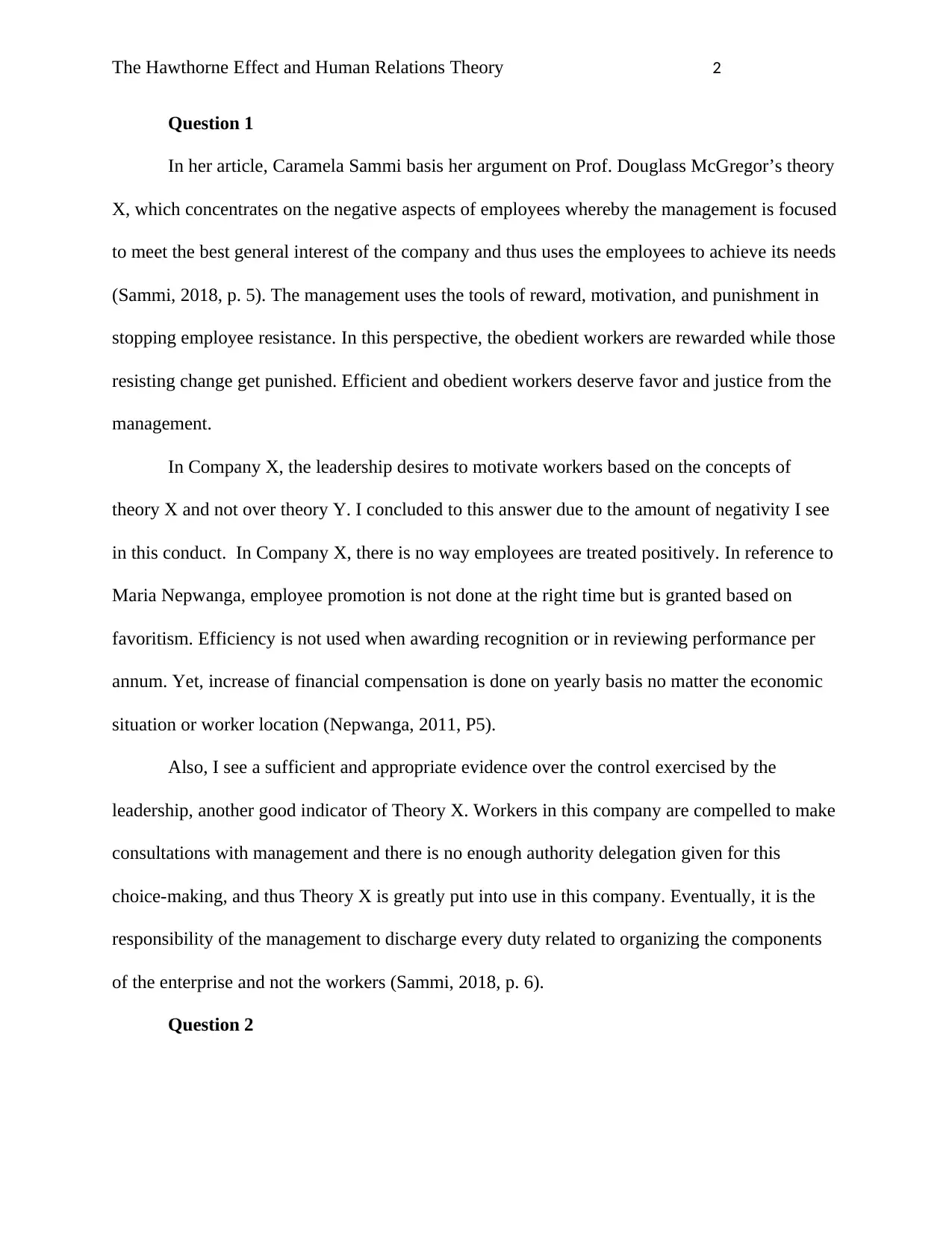
The Hawthorne Effect and Human Relations Theory 2
Question 1
In her article, Caramela Sammi basis her argument on Prof. Douglass McGregor’s theory
X, which concentrates on the negative aspects of employees whereby the management is focused
to meet the best general interest of the company and thus uses the employees to achieve its needs
(Sammi, 2018, p. 5). The management uses the tools of reward, motivation, and punishment in
stopping employee resistance. In this perspective, the obedient workers are rewarded while those
resisting change get punished. Efficient and obedient workers deserve favor and justice from the
management.
In Company X, the leadership desires to motivate workers based on the concepts of
theory X and not over theory Y. I concluded to this answer due to the amount of negativity I see
in this conduct. In Company X, there is no way employees are treated positively. In reference to
Maria Nepwanga, employee promotion is not done at the right time but is granted based on
favoritism. Efficiency is not used when awarding recognition or in reviewing performance per
annum. Yet, increase of financial compensation is done on yearly basis no matter the economic
situation or worker location (Nepwanga, 2011, P5).
Also, I see a sufficient and appropriate evidence over the control exercised by the
leadership, another good indicator of Theory X. Workers in this company are compelled to make
consultations with management and there is no enough authority delegation given for this
choice-making, and thus Theory X is greatly put into use in this company. Eventually, it is the
responsibility of the management to discharge every duty related to organizing the components
of the enterprise and not the workers (Sammi, 2018, p. 6).
Question 2
Question 1
In her article, Caramela Sammi basis her argument on Prof. Douglass McGregor’s theory
X, which concentrates on the negative aspects of employees whereby the management is focused
to meet the best general interest of the company and thus uses the employees to achieve its needs
(Sammi, 2018, p. 5). The management uses the tools of reward, motivation, and punishment in
stopping employee resistance. In this perspective, the obedient workers are rewarded while those
resisting change get punished. Efficient and obedient workers deserve favor and justice from the
management.
In Company X, the leadership desires to motivate workers based on the concepts of
theory X and not over theory Y. I concluded to this answer due to the amount of negativity I see
in this conduct. In Company X, there is no way employees are treated positively. In reference to
Maria Nepwanga, employee promotion is not done at the right time but is granted based on
favoritism. Efficiency is not used when awarding recognition or in reviewing performance per
annum. Yet, increase of financial compensation is done on yearly basis no matter the economic
situation or worker location (Nepwanga, 2011, P5).
Also, I see a sufficient and appropriate evidence over the control exercised by the
leadership, another good indicator of Theory X. Workers in this company are compelled to make
consultations with management and there is no enough authority delegation given for this
choice-making, and thus Theory X is greatly put into use in this company. Eventually, it is the
responsibility of the management to discharge every duty related to organizing the components
of the enterprise and not the workers (Sammi, 2018, p. 6).
Question 2
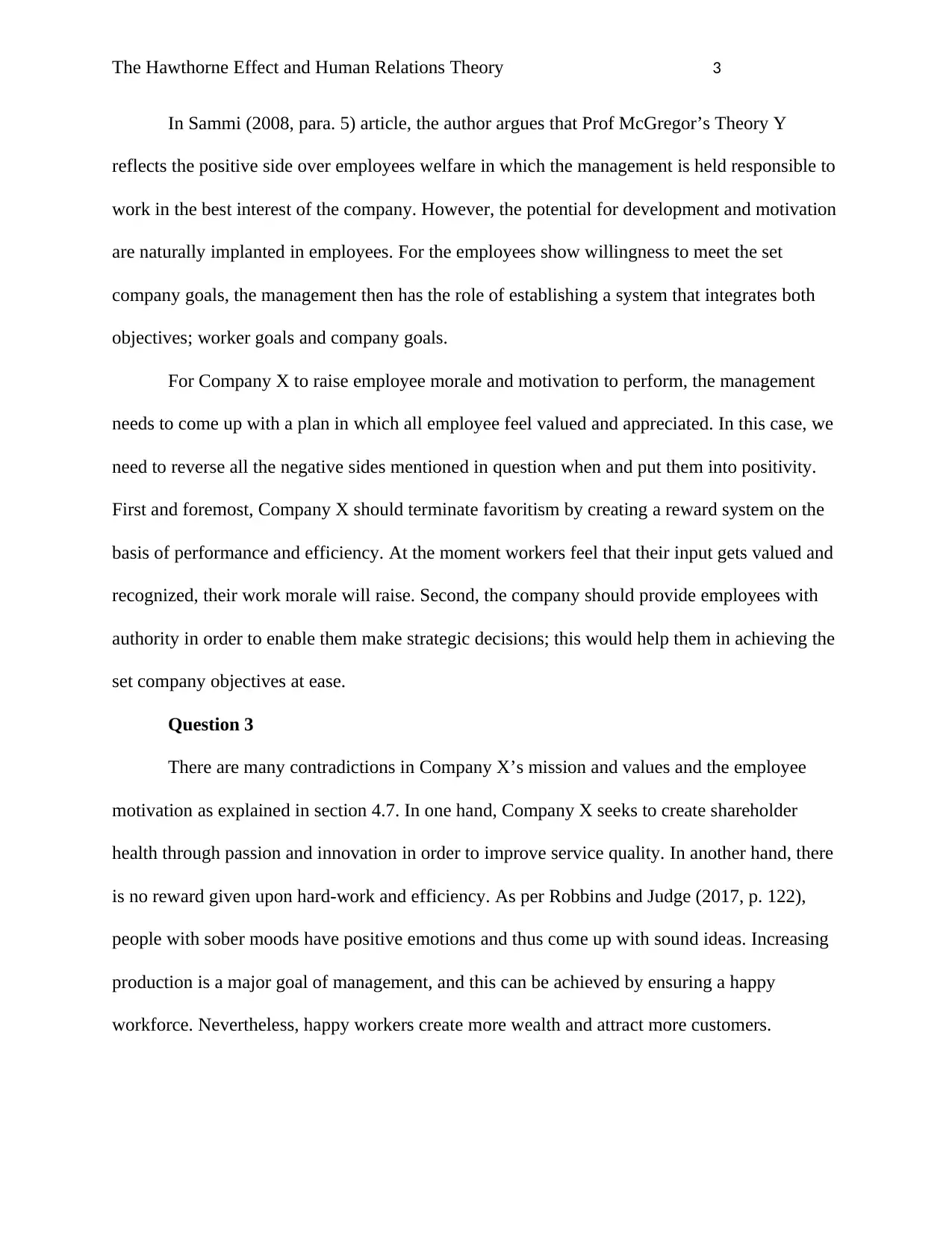
The Hawthorne Effect and Human Relations Theory 3
In Sammi (2008, para. 5) article, the author argues that Prof McGregor’s Theory Y
reflects the positive side over employees welfare in which the management is held responsible to
work in the best interest of the company. However, the potential for development and motivation
are naturally implanted in employees. For the employees show willingness to meet the set
company goals, the management then has the role of establishing a system that integrates both
objectives; worker goals and company goals.
For Company X to raise employee morale and motivation to perform, the management
needs to come up with a plan in which all employee feel valued and appreciated. In this case, we
need to reverse all the negative sides mentioned in question when and put them into positivity.
First and foremost, Company X should terminate favoritism by creating a reward system on the
basis of performance and efficiency. At the moment workers feel that their input gets valued and
recognized, their work morale will raise. Second, the company should provide employees with
authority in order to enable them make strategic decisions; this would help them in achieving the
set company objectives at ease.
Question 3
There are many contradictions in Company X’s mission and values and the employee
motivation as explained in section 4.7. In one hand, Company X seeks to create shareholder
health through passion and innovation in order to improve service quality. In another hand, there
is no reward given upon hard-work and efficiency. As per Robbins and Judge (2017, p. 122),
people with sober moods have positive emotions and thus come up with sound ideas. Increasing
production is a major goal of management, and this can be achieved by ensuring a happy
workforce. Nevertheless, happy workers create more wealth and attract more customers.
In Sammi (2008, para. 5) article, the author argues that Prof McGregor’s Theory Y
reflects the positive side over employees welfare in which the management is held responsible to
work in the best interest of the company. However, the potential for development and motivation
are naturally implanted in employees. For the employees show willingness to meet the set
company goals, the management then has the role of establishing a system that integrates both
objectives; worker goals and company goals.
For Company X to raise employee morale and motivation to perform, the management
needs to come up with a plan in which all employee feel valued and appreciated. In this case, we
need to reverse all the negative sides mentioned in question when and put them into positivity.
First and foremost, Company X should terminate favoritism by creating a reward system on the
basis of performance and efficiency. At the moment workers feel that their input gets valued and
recognized, their work morale will raise. Second, the company should provide employees with
authority in order to enable them make strategic decisions; this would help them in achieving the
set company objectives at ease.
Question 3
There are many contradictions in Company X’s mission and values and the employee
motivation as explained in section 4.7. In one hand, Company X seeks to create shareholder
health through passion and innovation in order to improve service quality. In another hand, there
is no reward given upon hard-work and efficiency. As per Robbins and Judge (2017, p. 122),
people with sober moods have positive emotions and thus come up with sound ideas. Increasing
production is a major goal of management, and this can be achieved by ensuring a happy
workforce. Nevertheless, happy workers create more wealth and attract more customers.
⊘ This is a preview!⊘
Do you want full access?
Subscribe today to unlock all pages.

Trusted by 1+ million students worldwide
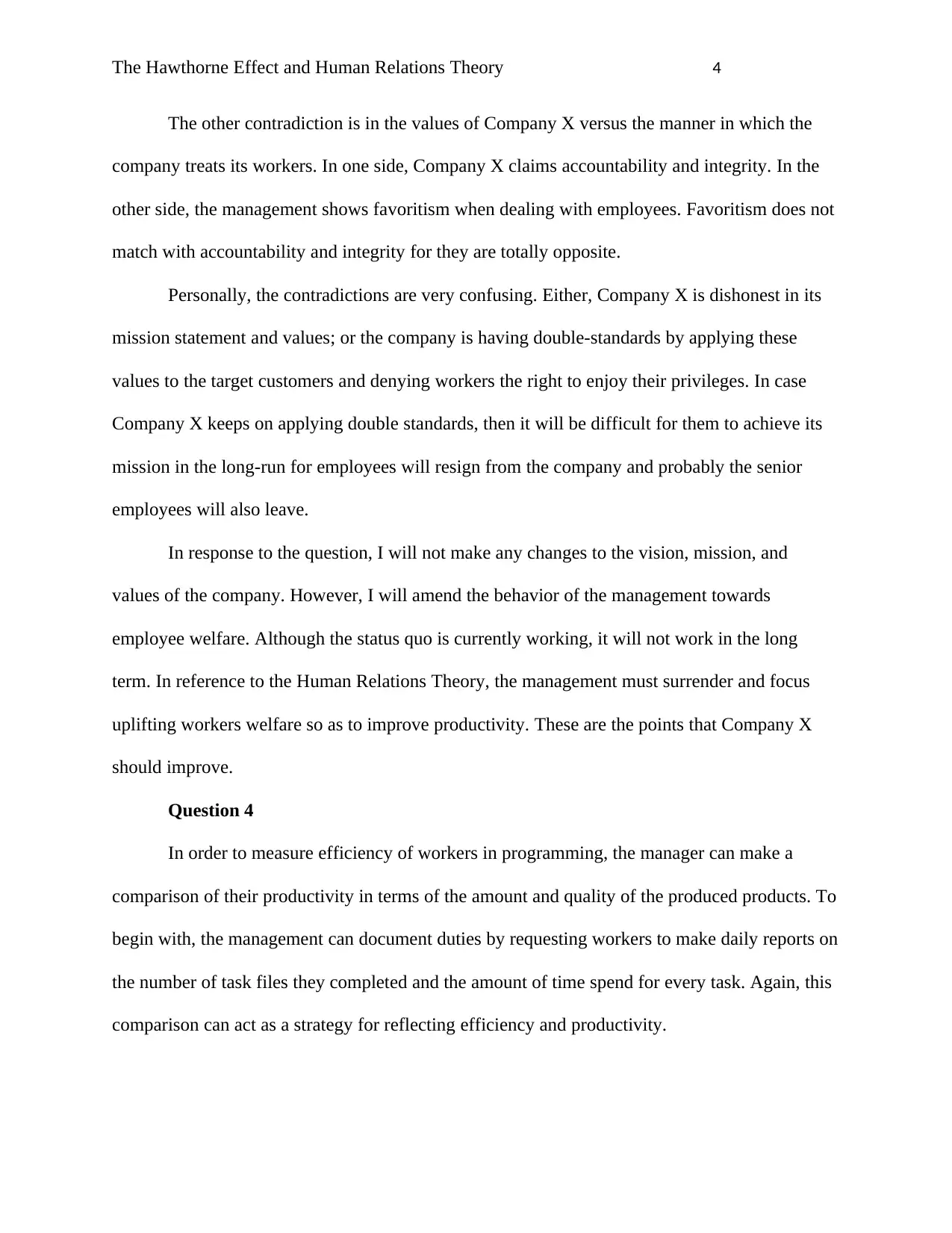
The Hawthorne Effect and Human Relations Theory 4
The other contradiction is in the values of Company X versus the manner in which the
company treats its workers. In one side, Company X claims accountability and integrity. In the
other side, the management shows favoritism when dealing with employees. Favoritism does not
match with accountability and integrity for they are totally opposite.
Personally, the contradictions are very confusing. Either, Company X is dishonest in its
mission statement and values; or the company is having double-standards by applying these
values to the target customers and denying workers the right to enjoy their privileges. In case
Company X keeps on applying double standards, then it will be difficult for them to achieve its
mission in the long-run for employees will resign from the company and probably the senior
employees will also leave.
In response to the question, I will not make any changes to the vision, mission, and
values of the company. However, I will amend the behavior of the management towards
employee welfare. Although the status quo is currently working, it will not work in the long
term. In reference to the Human Relations Theory, the management must surrender and focus
uplifting workers welfare so as to improve productivity. These are the points that Company X
should improve.
Question 4
In order to measure efficiency of workers in programming, the manager can make a
comparison of their productivity in terms of the amount and quality of the produced products. To
begin with, the management can document duties by requesting workers to make daily reports on
the number of task files they completed and the amount of time spend for every task. Again, this
comparison can act as a strategy for reflecting efficiency and productivity.
The other contradiction is in the values of Company X versus the manner in which the
company treats its workers. In one side, Company X claims accountability and integrity. In the
other side, the management shows favoritism when dealing with employees. Favoritism does not
match with accountability and integrity for they are totally opposite.
Personally, the contradictions are very confusing. Either, Company X is dishonest in its
mission statement and values; or the company is having double-standards by applying these
values to the target customers and denying workers the right to enjoy their privileges. In case
Company X keeps on applying double standards, then it will be difficult for them to achieve its
mission in the long-run for employees will resign from the company and probably the senior
employees will also leave.
In response to the question, I will not make any changes to the vision, mission, and
values of the company. However, I will amend the behavior of the management towards
employee welfare. Although the status quo is currently working, it will not work in the long
term. In reference to the Human Relations Theory, the management must surrender and focus
uplifting workers welfare so as to improve productivity. These are the points that Company X
should improve.
Question 4
In order to measure efficiency of workers in programming, the manager can make a
comparison of their productivity in terms of the amount and quality of the produced products. To
begin with, the management can document duties by requesting workers to make daily reports on
the number of task files they completed and the amount of time spend for every task. Again, this
comparison can act as a strategy for reflecting efficiency and productivity.
Paraphrase This Document
Need a fresh take? Get an instant paraphrase of this document with our AI Paraphraser
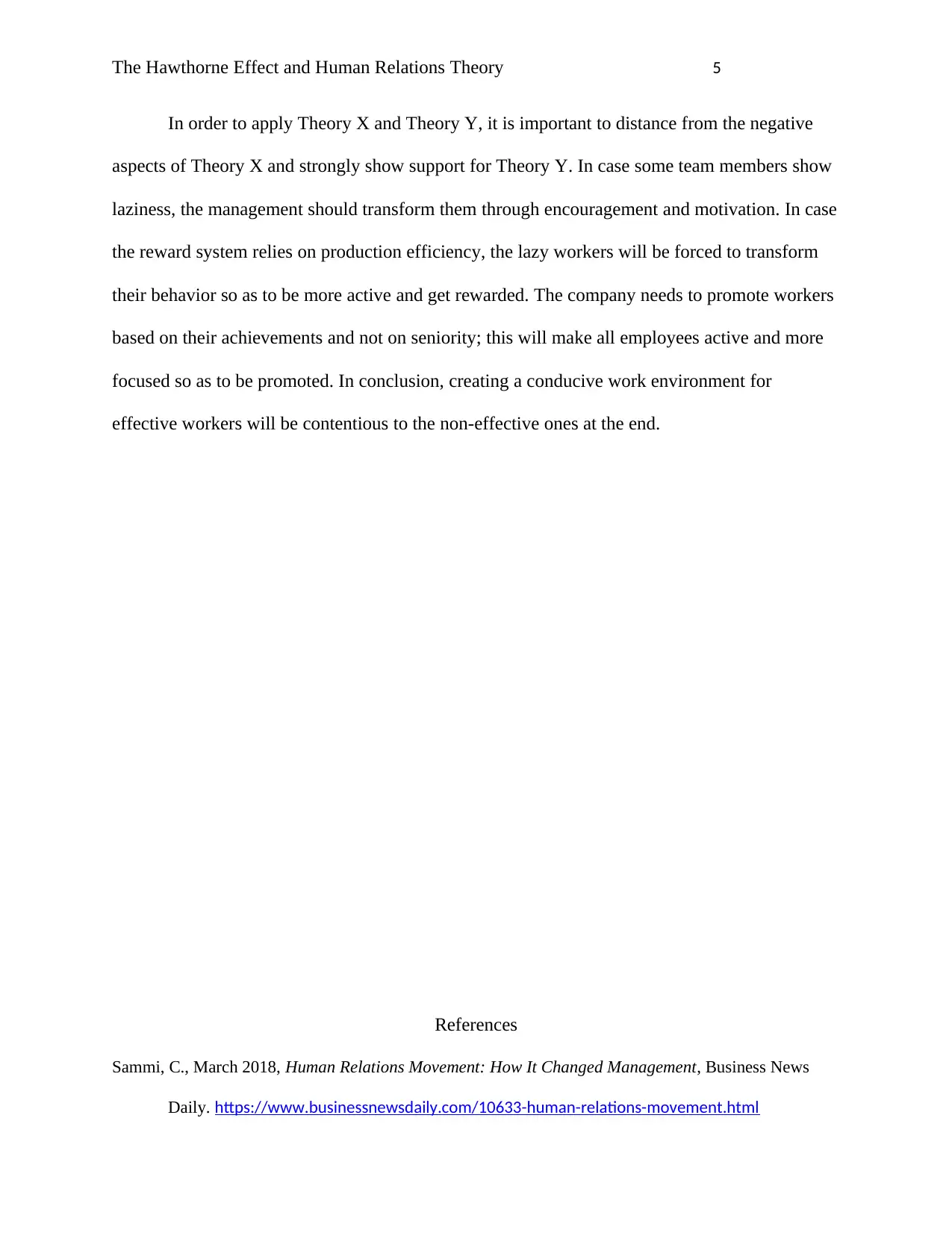
The Hawthorne Effect and Human Relations Theory 5
In order to apply Theory X and Theory Y, it is important to distance from the negative
aspects of Theory X and strongly show support for Theory Y. In case some team members show
laziness, the management should transform them through encouragement and motivation. In case
the reward system relies on production efficiency, the lazy workers will be forced to transform
their behavior so as to be more active and get rewarded. The company needs to promote workers
based on their achievements and not on seniority; this will make all employees active and more
focused so as to be promoted. In conclusion, creating a conducive work environment for
effective workers will be contentious to the non-effective ones at the end.
References
Sammi, C., March 2018, Human Relations Movement: How It Changed Management, Business News
Daily. https://www.businessnewsdaily.com/10633-human-relations-movement.html
In order to apply Theory X and Theory Y, it is important to distance from the negative
aspects of Theory X and strongly show support for Theory Y. In case some team members show
laziness, the management should transform them through encouragement and motivation. In case
the reward system relies on production efficiency, the lazy workers will be forced to transform
their behavior so as to be more active and get rewarded. The company needs to promote workers
based on their achievements and not on seniority; this will make all employees active and more
focused so as to be promoted. In conclusion, creating a conducive work environment for
effective workers will be contentious to the non-effective ones at the end.
References
Sammi, C., March 2018, Human Relations Movement: How It Changed Management, Business News
Daily. https://www.businessnewsdaily.com/10633-human-relations-movement.html
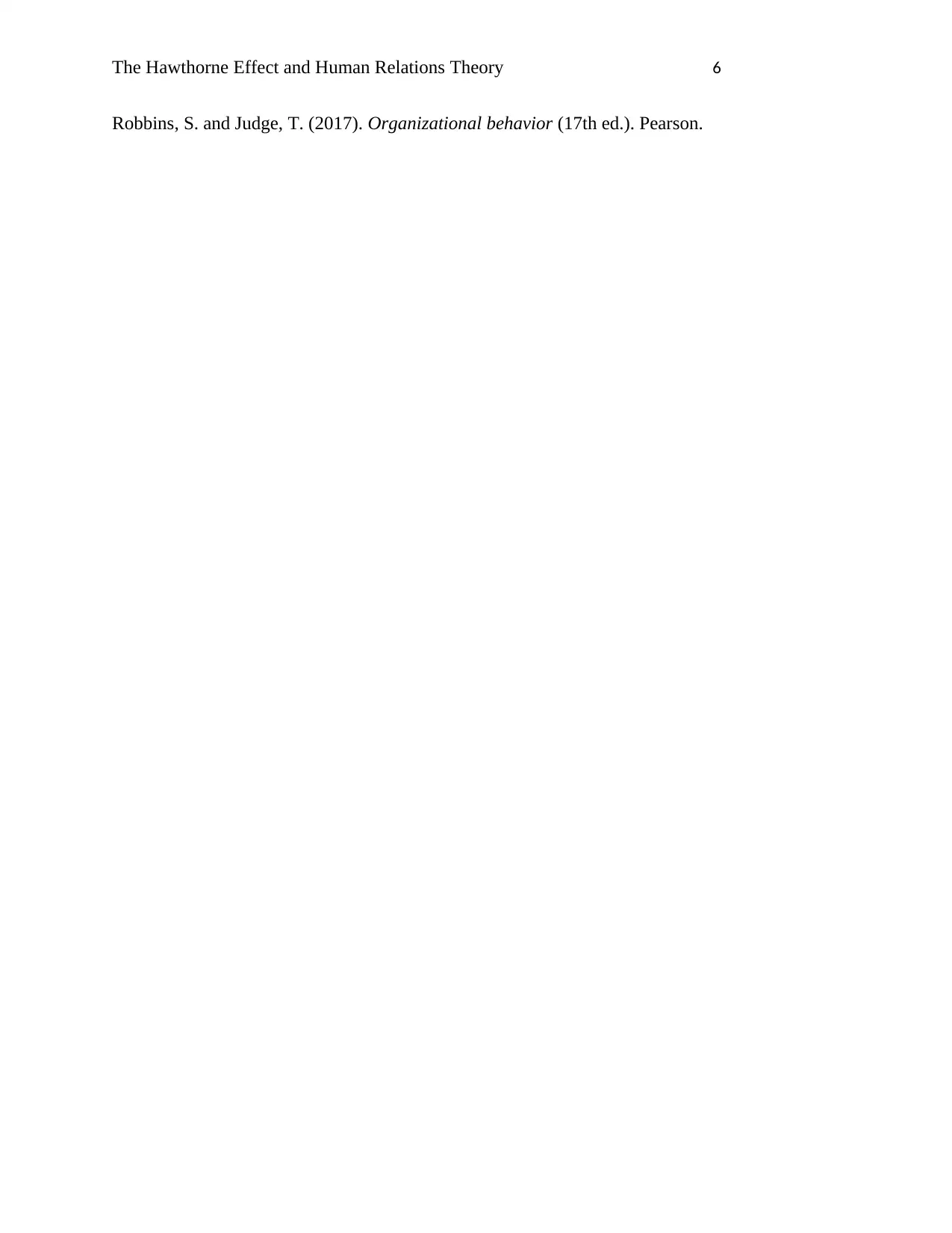
The Hawthorne Effect and Human Relations Theory 6
Robbins, S. and Judge, T. (2017). Organizational behavior (17th ed.). Pearson.
Robbins, S. and Judge, T. (2017). Organizational behavior (17th ed.). Pearson.
⊘ This is a preview!⊘
Do you want full access?
Subscribe today to unlock all pages.

Trusted by 1+ million students worldwide
1 out of 6
Related Documents
Your All-in-One AI-Powered Toolkit for Academic Success.
+13062052269
info@desklib.com
Available 24*7 on WhatsApp / Email
![[object Object]](/_next/static/media/star-bottom.7253800d.svg)
Unlock your academic potential
Copyright © 2020–2025 A2Z Services. All Rights Reserved. Developed and managed by ZUCOL.





